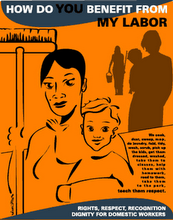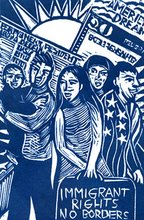Eric Beauchesne , CanWest News Service
Published: Tuesday, December 04, 2007OTTAWA - Canada is becoming a nation of immigrants again.
Canada's foreign-born population grew four times as fast as that of the Canadian-born population during the first half of this decade to reach a 75-year high of nearly one in five people living here, according to the latest analyses of data from last year's census.
The 13.6 per cent surge in Canada's foreign-born population between the 2001 and 2006 censuses, compared with the 3.3 per cent growth in the Canadian-born population, was mostly due to the arrival of 1.11 million new immigrants, Statistics Canada noted Tuesday in its analyses on "Immigration, citizenship, language, mobility and migration."
The proportion of foreign-born, which was at 22.2 per cent in 1931, fell during the Depression and the Second World War to a low of 14.7 per cent in 1951, and has been rising since.
The relatively rapid growth in Canada's immigrant population is seen as a potential offset to looming labour shortages that will follow the start of the retirement of the baby boom generation.
Supporting that view is the census finding that 57.3 per cent of immigrants to Canada over the past half decade were in the prime working age group of 25 to 54 years, compared with only 42.3 per cent of the Canadian-born population.
And they also tend to be better educated, especially the younger immigrants, added Jean-Pierre Corbeil, with Statistics Canada's language and demographics section.
"Everyone sees immigration as one way to counter this aging factor," he noted in an interview. "It's not the only way, but it's certainly one important way."
The continuing flow of immigrants here has also left Canada with a much higher proportion of foreign-born than the United States, 19.8 per cent compared to 12.5 per cent.
In fact, only Australia has a higher proportion of foreign-born than Canada.
And for the first time, in a land with more than 200 mother tongues, allophones - people whose mother tongue is neither English nor French - accounted for a full fifth of the population.
The increase in the proportion of allophones is mainly due to the immigrants who arrived during the latest census period, as four out of five of them had a mother tongue - the first language learned and still understood - that was neither French nor English.
These newcomers, nearly 60 per cent of whom were born in Asia, including the Middle East, made up almost 18 per cent of the foreign-born population in 2006, or 3.6 per cent of Canada's total population of 31.2 million.
The proportion of new immigrants who were born in Asia was unchanged from the previous census but was up from only 12.1 per cent 2-1/2 decades earlier, Statistics Canada noted.
And for the first time the foreign-born population from Asia and the Middle East in 2006 exceeded that from Europe.
Newcomers from Europe, who use to make up the majority of new immigrants to Canada, accounted for just 16.1 per cent over the half decade, down from more than 60 per cent as recently as 1971.
During the latest census period, just over 10 per cent of new immigrants were from Central and South America and the Caribbean, and another 10.6 per cent were born in Africa.
Regardless of where immigrants were from, separate Statistics Canada surveys found that Canada was the only choice for 98 per cent of them.
Those surveys found the largest proportion said they came to improve the future for their family, and when asked four years later why they planned to stay also cited the quality of life here and the positive future prospects for their family.
Meanwhile, Canada's three largest metropolitan areas became home to more than two-thirds of new immigrants, between two to three times the 27.1 per cent of Canada's total population who call Toronto, Vancouver or Montreal home.
Toronto accounts for 37.5 per cent of the total immigrant population, the highest of the three by far, and 40.4 per cent of recent immigrants.
While most of the recent immigrants live in the core of the metropolitan areas, more are also moving out to the suburbs.
A slightly higher proportion than during the previous census period -16.6 per cent compared with 14.3 per cent - also chose to settle in the smaller metropolitan areas of Calgary, Ottawa-Gatineau, Edmonton, Winnipeg, Hamilton and London.
Nearly 87 per cent of the foreign-born population live in three provinces: Ontario, with 54.9 per cent, British Columbia with 18.1 per cent, and Quebec with 13.8 per cent.
Those three provinces also received nearly 86 per cent of newcomers since 2001.
In contrast, foreign-born people account for less than four per cent of the population of Atlantic Canada.
Meanwhile, more than 85 per cent of the foreign-born who were entitled to become Canadian citizens had done so.
While only 2.8 per cent of all Canadian citizens, or 863,100, also had at least one other citizenship, four-fifths of those were foreign born, with the largest single proportion being the 14.7 per cent who held British citizenship, followed by 6.6 per cent Polish, and 5.4 American.
http://www.canada.com/topics/news/story.html?id=8383a923-f630-4367-9019-1ee9140de7eb















